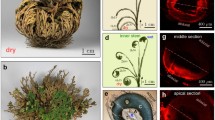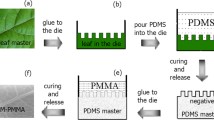Abstract
Many structural and functional properties possessed by plants have great potentials to stimulate new concepts and innovative ideas in the field of biomimetic engineering. The key inputs from biology can be used for creation of efficient and optimized structures. The study of the geometry and folding pattern of leaves of Mimosa pudica, referred as Sensitive Plant, reveals some of the peculiar characteristics during folding and unfolding. When the leaf is touched, it quickly folds its leaflets and pinnae and droops downward at the petiole attachment. With the help of experiments on simulation model, the variations in angle of leaflets and degree of compaction after folding are investigated.
Similar content being viewed by others
References
Braam J. In touch: Plant responses to mechanical stimuli. The New Phytologist, 2005, 165, 373–389.
De Focatiis D S, Guest S D. Deployable membranes designed from folding tree leaves. Philosophical Transactions of Royal Society of London A, 2002, 15, 227–238.
Kobayashi H, Kresling B, Vincent J F V. The geometry of unfolding tree leaves. Proceedings of Royal Society London B: Biological Science, 1998, 265, 147–154.
Vogel S. Drag and reconfiguration of broad leaves in high winds. Journal of Experimental Botany, 1989, 40, 941–948.
Niklas K J. Plant Biomechanics: An Engineering Approach to Plant Form and Function, University of Chicago Press, Chicago, USA, 1992.
Unda J, Weisz J, Rivacoba J, Ruiz Uríen I, Capitanio R S. Family of deployable/retractable structures for space application. Acta Astronautica, 1994, 32, 767–784.
Miura K, Natori M. 2-D array experiment on board a space flyer unit. Space Solar Power Review, 1985, 5, 345–356.
Guest S D, Pellegrino S. Inextensional wrapping of flat membranes. Proceedings of 1st International Seminar on Structural Morphology, Motro R, Wester T (eds), Montpellier, Cananda, 1992, 203–215.
Herbig A, Kull U. Leaves and ramification. Proceedings of 2nd International Symposium, Part 2, Stuttgart, Germany, 1991, 109–117.
Howard R A. Flora of the Lesser Antilles, Leeward and Windward Islands, Vol. 4, part 1, Dicotyledoneae, Arnold Arboretum-Harvard University, USA, 1977, 673.
Holm L G, Plucknett D L, Pancho J V, Herberger J P, East-West Center. The World’s Worst Weeds: Distribution and Biology, University Press of Hawaii, USA, 1977, 609.
Author information
Authors and Affiliations
Corresponding author
Rights and permissions
About this article
Cite this article
Patil, H.S., Vaijapurkar, S. Study of the geometry and folding pattern of leaves of Mimosa pudica. J Bionic Eng 4, 19–23 (2007). https://doi.org/10.1016/S1672-6529(07)60008-0
Published:
Issue Date:
DOI: https://doi.org/10.1016/S1672-6529(07)60008-0




